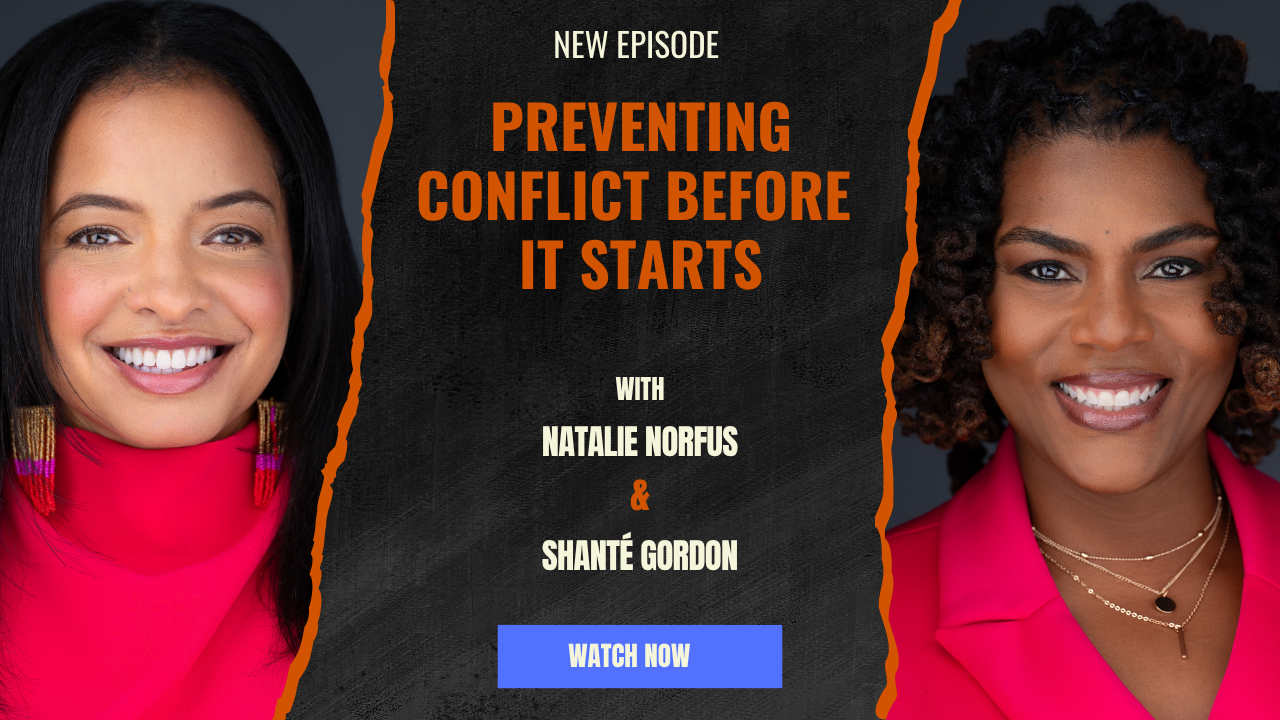Preventing Conflict Before It Starts

Conflict in the workplace isn’t always loud. It doesn’t always announce itself with slammed doors, aggressive emails, or tense team meetings. Often, it begins quietly—with unspoken resentment, subtle disengagement, or that sinking feeling that something’s “off.” And while conflict itself isn’t inherently a bad thing, when it’s left unchecked, it festers—and can ultimately sabotage your team, your leadership, and your culture.
In this episode of What’s the DEIL?, Shante and Natalie take listeners deep into the uncomfortable, nuanced terrain of workplace conflict—not just the messy outcomes, but the root causes and early indicators that leaders often miss. The episode makes one thing clear: if you’re waiting for a formal complaint or a full-blown fallout to address team tensions, you’re already behind.
Here’s why preventing conflict doesn’t mean avoiding it—it means addressing it before it becomes combustible.
The Real Cost of Conflict
Let’s start with the numbers. According to research cited in the episode, the average U.S. employee spends 2.8 hours per week dealing with conflict. That translates into a staggering $359 billion in lost productivity each year. And that doesn’t even factor in the emotional exhaustion, reduced innovation, attrition, or the mental bandwidth that gets eaten up when unresolved issues dominate your workplace energy.
But even those figures might be lowball estimates. As Natalie points out, most people don’t just spend a few hours navigating conflict—they live in it. They process it after work, vent about it to friends, strategize how to avoid it, and sometimes carry it home. It bleeds into culture in ways leaders rarely measure until it’s too late.
The bottom line? Conflict is expensive, and much of it is avoidable with the right leadership tools.
Conflict Isn’t the Problem—Avoidance Is
One of the most refreshing insights from the episode is the reminder that conflict, in and of itself, is neutral. It’s not inherently good or bad—it’s inevitable. When people work together, especially across teams, roles, and backgrounds, disagreements will happen.
The danger arises when leaders view conflict as a threat rather than an inevitable part of collaboration. That’s when issues go unspoken. People pull back. Psychological safety disappears. And the moment where a simple conversation could’ve resolved something passes.
Natalie shares an example of a leader whose default response to conflict was dismissal and micromanagement. He claimed to value direct communication but actively shut down feedback and diminished his team members in public forums. The result? A formal investigation, a shattered culture, and a team unwilling to be honest with him—or each other.
It didn’t have to go that way. However, avoidance, ego, and power imbalance are a formula for disaster.
The Leadership Skill That Changes Everything
Self-awareness isn’t a soft skill—it’s a strategic one.
The leaders who prevent conflict before it escalates are the ones who understand how they present themselves in a room. They understand how their communication style lands with others. They’re attuned to the energy of their team. And most importantly, they’re willing to listen even when the feedback is hard.
Shante and Natalie emphasize that inclusive leaders don’t just respond to conflict; they anticipate it. They read the room. They notice when someone’s tone changes or when a once-vocal team member goes quiet. They recognize early warning signs like disengagement, avoidance, or drops in collaboration, and they don’t brush them off.
Instead, they lean in. They ask better questions. They invite conversation. Not with a performative, “Is everything okay?” but with curiosity, context, and openness to whatever the answer may be.
How to Spot Conflict Before It Boils Over
So, what are those early signs leaders should be watching for?
- Silence from vocal team members
When someone who normally engages in meetings stops speaking up, that’s not “just a mood”—it could be a signal of underlying tension or disconnection. - Withdrawal from collaboration
If your team Slack feels quieter or people are avoiding cross-functional projects, pay attention. Disengagement is often the first sign of emotional discomfort. - High turnover or quiet quitting
When people leave—or worse, stay but check out—you’ve likely missed opportunities to resolve smaller issues early. - Lack of transparency or candor
If no one tells the truth in meetings anymore, or you start hearing about issues through whispers instead of direct reports, your culture may be operating under fear.
And here’s the hardest truth: By the time you notice these things, the conflict may already be doing damage. That’s why early, consistent, low-stakes conversations are crucial.
From Conflict Avoidance to Conflict Fluency
The antidote to conflict isn’t silence—it’s skill.
Shante and Natalie suggest several ways leaders can build healthier team dynamics before things get messy:
- Normalize disagreement.
Conflict doesn’t have to be combative. Teams that disagree well are often the most innovative. Create space for respectful debate and model what it looks like. - Give and receive feedback regularly.
Don’t wait for the annual review. Frequent, thoughtful feedback builds trust and keeps small issues from growing into major grievances. - Establish community agreements.
Whether it’s “assume good intent” or “speak from your experience,” creating shared norms for communication sets a tone that helps people feel safe being honest. - Train your managers.
Most conflict arises—or is exacerbated—by ineffective or insecure management. Give your managers tools to navigate tough conversations with confidence and compassion. - Check your ego.
Being a leader doesn’t mean being right all the time. If you can’t be challenged, you can’t grow—and neither can your team.
What Happens When You Don’t
When conflict is left to fester, it doesn’t just damage one relationship—it reshapes the culture.
People stop talking. Or worse, they only talk to HR or the board when things have gone too far. Shante points out that some leaders don’t realize they’re cultivating a culture of fear until anonymous complaints start pouring in, or employees leave en masse. By then, the cost isn’t just emotional—it’s financial, reputational, and operational.
It’s not dramatic to say: one mishandled conflict can unravel an entire team.
The Invitation
This episode isn’t a lecture—it’s a mirror. Whether you’re a CEO, a people manager, or an HR leader, you are the thermostat for your team. You set the tone. You decide whether feedback is welcomed or weaponized. And you have the power to turn conflict into connection—or chaos.
So here’s the deal: You can’t eliminate conflict. However, you can ensure your team is prepared for it. You can create a workplace where disagreement doesn’t mean destruction. And you can start by having the conversations that feel a little uncomfortable before they become unavoidable.
Because the best way to prevent conflict isn’t to dodge it. It’s to make room for it, early and often with courage, care, and clarity.
Connect With Us
If you found this discussion compelling, we invite you to connect with us further. Here are some ways to stay in touch:
- Follow Natalie Norfus on LinkedIn
- Follow Shanté Gordon on LinkedIn
- Book a consultation with The Norfus Firm
- Follow What’s the DEIL on Instagram and TikTok
